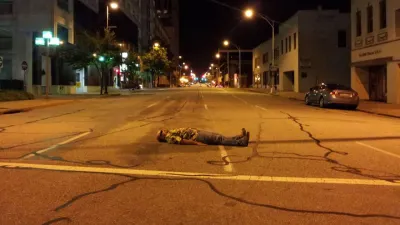From his home in Brainerd, Minnesota (population 13,500), this fiscally conservative engineer leads a growing movement. His slow-and-steady approach to urban development has real bipartisan appeal.

As a civil engineer, Charles Marohn used to oversee projects that widely overshot the mark, providing unnecessary infrastructure and saddling towns with inflated costs. He realized that the suburban mainstream offered "solutions that not only encouraged sprawl, but also created places that were financially unsustainable."
Peter Callaghan reports on the man behind Strong Towns, first a blog and now a non-profit dedicated to the economic viability of existing communities.
Marohn is anti-suburb, but he doesn't fit the typical urbanist profile. "He describes himself as a fiscally conservative Republican; most of those who share his philosophy are liberal Democrats. Also, he was a civil engineer first, not a city planner."
"It's a perspective that has led Marohn to conclude that the nation's 70-year experiment with suburban development is a failure — because it is economically unsustainable. That is, the lack of density does not produce tax revenue necessary to cover current services, let alone the long-term costs of maintaining and replacing those services."
In Marohn's words, "Woodbury is going away, no matter what. There is no renewal process. There is no next step in its evolution." He sees both parties as complicit in an "infrastructure cult" dedicated to top-down projects, be they highways or transit. Instead, he says, we should look to the period before the postwar suburban boom for wiser models.
FULL STORY: Why a conservative Republican from northern Minnesota wants to kill the suburbs

National Parks Layoffs Will Cause Communities to Lose Billions
Thousands of essential park workers were laid off this week, just before the busy spring break season.

Retro-silient?: America’s First “Eco-burb,” The Woodlands Turns 50
A master-planned community north of Houston offers lessons on green infrastructure and resilient design, but falls short of its founder’s lofty affordability and walkability goals.

Delivering for America Plan Will Downgrade Mail Service in at Least 49.5 Percent of Zip Codes
Republican and Democrat lawmakers criticize the plan for its disproportionate negative impact on rural communities.

Test News Post 1
This is a summary

Test News Headline 46
Test for the image on the front page.

Balancing Bombs and Butterflies: How the National Guard Protects a Rare Species
The National Guard at Fort Indiantown Gap uses GIS technology and land management strategies to balance military training with conservation efforts, ensuring the survival of the rare eastern regal fritillary butterfly.
Urban Design for Planners 1: Software Tools
This six-course series explores essential urban design concepts using open source software and equips planners with the tools they need to participate fully in the urban design process.
Planning for Universal Design
Learn the tools for implementing Universal Design in planning regulations.
EMC Planning Group, Inc.
Planetizen
Planetizen
Mpact (formerly Rail~Volution)
Great Falls Development Authority, Inc.
HUDs Office of Policy Development and Research
NYU Wagner Graduate School of Public Service





























